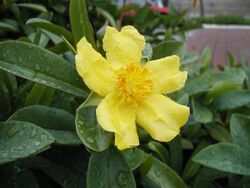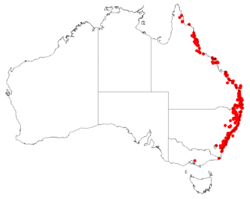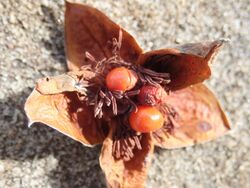Biology:Hibbertia scandens
| Snake vine | |
|---|---|

| |
| Hibbertia scandens at Dulwich Hill | |
| Scientific classification | |
| Kingdom: | Plantae |
| Clade: | Tracheophytes |
| Clade: | Angiosperms |
| Clade: | Eudicots |
| Order: | Dilleniales |
| Family: | Dilleniaceae |
| Genus: | Hibbertia |
| Species: | H. scandens
|
| Binomial name | |
| Hibbertia scandens (Willd.) Dryand.[1]
| |

| |
| Collection data from the AVH | |
| Synonyms[1] | |
|
List
| |

Hibbertia scandens, sometimes known by the common names snake vine, climbing guinea flower and golden guinea vine,[2] is a species of flowering plant in the family Dilleniaceae and is endemic to eastern Australia. It is climber or scrambler with lance-shaped or egg-shaped leaves with the narrower end towards the base, and yellow flowers with more than thirty stamens arranged around between three and seven glabrous carpels.
Description
Hibbertia scandens is a climber or scrambler with stems 2–5 m (6 ft 7 in–16 ft 5 in) long. The leaves are lance-shaped or egg-shaped with the narrower end towards the base, 30–80 mm (1.2–3.1 in) long and 15–25 mm (0.59–0.98 in) wide, sessile and often stem-clasping with the lower surface silky-hairy. The flowers are arranged in leaf axils, each flower on a peduncle 2–4 mm (0.079–0.157 in) long. The sepals are 15–25 mm (0.59–0.98 in) long and the petals are yellow, 20–30 mm (0.79–1.18 in) long with more than thirty stamens surrounding the three to seven glabrous carpels. Flowering occurs in most months and the fruit is an orange aril.[2][3][4]
Plants near the coast tend to be densely hairy with spatula-shaped leaves and have flowers with six or seven carpels, whilst those further inland are usually more or less glabrous with tapering leaves and flowers with three or four carpels.[3]
The flowers have been reported as having an unpleasant odour[5] variously described as similar to mothballs[6] or animal urine[7] or sweet but with "a pronounced faecal element".[7]
Taxonomy
Snake vine was first formally described in 1799 by German botanist Carl Willdenow who gave it the name Dillenia scandens in Species Plantarum.[8][9] In 1805, Swedish botanist Jonas Dryander transferred the species into the genus Hibbertia as H. scandens in the Annals of Botany.[10] The specific epithet (scandens) is derived from Latin, and means "climbing".[11]
Three varieties of H. scandens have been described and the names are accepted by the Australian Plant Census but not by the National Herbarium of New South Wales:[1]
- Hibbertia scandens var. glabra (Maiden) C.T.White;[12]
- Hibbertia scandens var. oxyphylla Domin;[13]
- Hibbertia scandens (Willd.) Dryand. var. scandens.[14]
Distribution and habitat
Hibbertia scandens grows on coastal sand dunes, in open forest and at rainforest margins in an area extending from Proserpine in north-eastern Queensland to the far south coast of New South Wales.[3][5] The species also occurs as an uncommon weed in Auckland, New Zealand.[15]
Ecology
Some pollination surveys place beetles (from the Scarabaeidae, Chrysomelidae and Curculionidae) as the main pollinators of Hibbertia scandens, as well as Hibbertia hypericoides (DC.) Benth., and other species from the Dilleniaceae family, they also place bees and flies as secondary importance (such as Keighery 1975).[16][17]
Use in horticulture
This species is common in cultivation and adapts to a wide range of growing conditions, including where it is exposed to salt-laden winds. Although it readily grows in semi-shaded areas, it flowers best in full sun and prefers well-drained soil. As it is only hardy down to 5 °C (41 °F) it requires winter protection in temperate regions. In the United Kingdom it has gained the Royal Horticultural Society’s Award of Garden Merit.[18][19]
In popular culture
Hibbertia scandens appeared on an Australian postage stamp in 1999.[20]
See also
- List of flora on stamps of Australia
References
- ↑ 1.0 1.1 1.2 "Hibbertia scandens". Australian Plant Census. https://biodiversity.org.au/nsl/services/apc-format/display/90786.
- ↑ 2.0 2.1 "Hibbertia scandens". Australian Native Plants Society (Australia). https://anpsa.org.au/plant_profiles/hibbertia-scandens/.
- ↑ 3.0 3.1 3.2 "Hibbertia scandens". Royal Botanic Garden Sydney. https://plantnet.rbgsyd.nsw.gov.au/cgi-bin/NSWfl.pl?page=nswfl&lvl=sp&name=Hibbertia~scandens.
- ↑ Carolin, Roger C.; Tindale, Mary D. (1994). Flora of the Sydney region (4th ed.). Chatswood, NSW: Reed. pp. 275. ISBN 0730104001.
- ↑ 5.0 5.1 "Environmental Protection Agency - Queensland Government - Snake Vine (Hibbertia scandens)". Archived from the original on 2011-03-21. https://web.archive.org/web/20110321005410/http://www.derm.qld.gov.au/register/p00289aa.pdf. Retrieved 2010-11-19.
- ↑ Indigenous plants of Greater Taree (third ed.). Greater Taree City Council. 2010. p. 65. http://www.gtcc.nsw.gov.au/files/FP_Strategic_Environment/Indigenous_Plants_of_Greater_Taree_Version_3.pdf. Retrieved 31 January 2012.
- ↑ 7.0 7.1 Hawksewood, Trevor J. (31 August 1992). "Diphucephala benhardti sp. nov.(Coleoptera: Scarabaediae:Melonthinae) from heathlands of north-eastern New South Wales, Australia and its association with Hibbertia flowers (Dilleniaceae)". Giornale Italiano di Entomologia 6: 109–117. http://www.calodema.com/freefiles/156.pdf. Retrieved 15 February 2010.
- ↑ "Dillenia scandens". APNI. http://id.biodiversity.org.au/instance/apni/534749.
- ↑ Willdenow, Carl Ludwig (1799). Species Plantarum. 2. p. 1251. https://www.biodiversitylibrary.org/item/84237#page/425/mode/1up. Retrieved 15 September 2021.
- ↑ "Hibbertia scandens". APNI. http://id.biodiversity.org.au/instance/apni/512563.
- ↑ William T. Stearn (1992). Botanical Latin. History, grammar, syntax, terminology and vocabulary (4th ed.). Portland, Oregon: Timber Press. p. 487.
- ↑ "Hibbertia scandens var. glabra". Australian Plant Census. https://biodiversity.org.au/nsl/services/apc-format/display/90814.
- ↑ "Hibbertia scandens var. oxyphylla". Australian Plant Census. https://biodiversity.org.au/nsl/services/apc-format/display/90832.
- ↑ "Hibbertia scandens var. oxyphylla". Australian Plant Census. https://biodiversity.org.au/nsl/services/apc-format/display/90842.
- ↑ "Hibertia scandens". New Zealand Plant Conservation Netword. https://www.nzpcn.org.nz/flora/species/hibbertia-scandens/.
- ↑ Keighery, G.J. (1975). "Pollination of Hibbertia hypericoides (Dilleniaceae) and its evolutionary significance.". Journal of Natural History 9: 681-684..
- ↑ Rech, André Rodrigo; Manente-Balestieri, Fatima Cristina de Lazari; Absy, Maria Lúcia (June 2011). "Reproductive biology of Davilla kunthii A. St-Hil. (Dilleniaceae) in Central Amazonia". Acta Bot. Bras. 25 (2): 487–496. doi:10.1590/S0102-33062011000200024.
- ↑ "RHS Plantfinder - Hibbertia scandens". https://www.rhs.org.uk/Plants/48070/i-Hibbertia-scandens-i/Details. Retrieved 6 March 2018.
- ↑ "AGM Plants - Ornamental". Royal Horticultural Society. July 2017. p. 48. https://www.rhs.org.uk/plants/pdfs/agm-lists/agm-ornamentals.pdf. Retrieved 6 March 2018.
- ↑ "Plant: Hibbertia scandens". Australian National Botanic Gardens. https://www.anbg.gov.au/stamps/stamp-hibbertia99.html.
External links
Wikidata ☰ Q5750660 entry
 |

